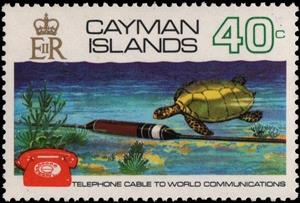Stamp: Cable,Turtle,Telephone (Cayman Islands 1972)
Cable,Turtle,Telephone (Cayman Islands 1972)
10 January (Cayman Islands ) within release World Communications goes into circulation Stamp Cable,Turtle,Telephone face value 40 Cayman Islands cent
| Stamp Cable,Turtle,Telephone in catalogues | |
|---|---|
| Stamp Number: | Sn:KY 299 |
Stamp is square format.
Also in the issue World Communications:
- Stamp - Cable,Turtle,Telephone face value 2;
- Stamp - Cable,Turtle,Telephone face value 10;
- Stamp - Cable,Turtle,Telephone face value 40;
Stamp Cable,Turtle,Telephone it reflects the thematic directions:
A telephone, colloquially referred to as a phone, is a telecommunications device that permits two or more users to conduct a conversation when they are too far apart to be easily heard directly. A telephone converts sound, typically and most efficiently the human voice, into electronic signals that are transmitted via cables and other communication channels to another telephone which reproduces the sound to the receiving user. The term is derived from Ancient Greek: τῆλε, romanized: tēle, lit. 'far' and φωνή (phōnē, voice), together meaning distant voice.
Marine life, or sea life or ocean life, refers to the plants, animals and other organisms that live in the salt water of the sea or ocean, or the brackish water of coastal estuaries. At a fundamental level, marine life helps determine the very nature of our planet. Marine organisms produce much of the oxygen we breathe. Shorelines are in part shaped and protected by marine life, and some marine organisms even help create new land. Altogether there are 230,000 documented marine species, including over 16,000 species of fish, and it has been estimated that nearly two million marine species are yet to be documented. Marine species range in size from the microscopic, including plankton and phytoplankton which can be as small as 0.02 micrometres, to huge cetaceans (whales, dolphins and porpoises) which in the case of the blue whale reach up to 33 metres (109 feet) in length, being the largest known animal.
Turtles are reptiles of the order Testudines, characterized by a special shell developed mainly from their ribs. Modern turtles are divided into two major groups, the Pleurodira (side necked turtles) and Cryptodira (hidden necked turtles), which differ in the way the head retracts. There are 360 living and recently extinct species of turtles, including land-dwelling tortoises and freshwater terrapins. They are found on most continents, some islands and, in the case of sea turtles, much of the ocean. Like other amniotes (reptiles, birds, and mammals) they breathe air and do not lay eggs underwater, although many species live in or around water.



